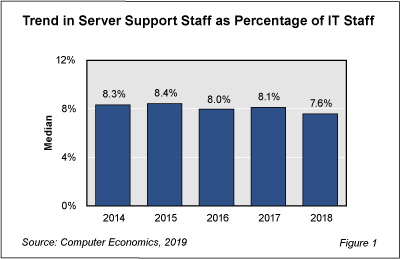The demand for server support administrators has been declining over the past decade, and this trend will continue. Why the decline? Cloud computing is allowing IT organizations to reduce their on-premises data center infrastructure, while virtualization and automation are making the servers that remain on-premises easier to administer.
As shown in Figure 1 from our full report, Server Support Staffing Ratios, server support personnel as a percentage of the IT staff dropped at the median from 8.1% in 2017 to 7.6% in 2018. The trend since 2015 (8.4%) has been a slow decline, despite a blip in 2017. For some historical perspective, the ratio was 11.5% in 2012.

Software as a service (SaaS) is another huge factor in the reduction of server support staff. SaaS has become the standard choice for many new software deployments. In fact, many companies we have spoken to say that they no longer consider on-premises solutions for new software deployments.
“Many IT organizations want to shed their infrastructure burden and get out of the data center business,” said Tom Dunlap, director of research for Irvine, Calif.-based Computer Economics. “But few organizations have been able to completely eliminate their data centers. So optimization is the key. IT leaders need to track the state of the cloud transformation as they gauge hiring for the present and think about the skills they will need in the future.”
In this report, we use a broad definition for server support staff that covers the majority of employees in the data center. The category specifically includes systems administrators, systems programmers, systems engineers, storage administrators, and facilities engineers. It also includes computer operations staff, including computer operators, job schedulers, and production control personnel.
For this category, it also is important to understand who is excluded from the headcount. Our count of server support staffing does not include database administrators, network support personnel, or communications system support personnel. Also excluded are IT managers, although shift supervisors and other data center managers are counted if they spend the bulk of their time doing the work as opposed to managing others.
To examine this important IT staffing question, the full report starts with an assessment of how server support staffing has changed over time. Next we provide four key metrics for benchmarking server support staff: server support staff as a percentage of the total IT staff, users per server support staff member, operating system (OS) instances per server support staff member, and physical servers per server support staff member. We provide these metrics for small, midsize, and large organizations. We also assess how industry sector can influence server support staffing ratios. We conclude with recommendations for improving server support productivity.
This Research Byte is a brief overview of our report on this subject, Server Support Staffing Ratios. The full report is available at no charge for Computer Economics clients, or it may be purchased by non-clients directly from our website (click for pricing).
Do you also need staffing ratios for other IT job functions? Consider this collection of all of our staffing ratio reports, which bundles them all into a single report at a significant discount: IT Staffing Ratios–Special Report Bundle.





